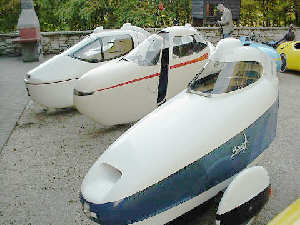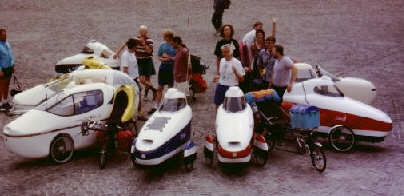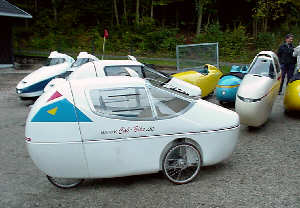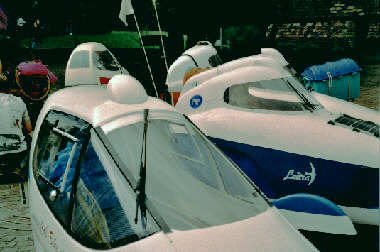Advantages of velomobiles
Velomobiles differ totally from existing vehicles that are known from everyday traffic. Thatīs why they need a lot of explanation - either it is a prototype or a product from a small scale production. In a closer sense, velomobiles are fully faired recumbents. They are constructed for everyday use and offer a full rain protection.
The main question is: "Why should I use a velomobile and what are the advantages comparted to a bicycle or to a car?"
 |
One main difference between a velomobile and a standard bicycle rider is, that velomobilists almost use the same clothes in summer and winter time. This is one main reason for using a velomobile. There is no need to look out the window in the morning. There is no rain wear that hinderes cycling, and one can ride dressed in a fine suit. A good velomobile offers a proper ventilation that has to be well constructed. The direct relative wind is missing, but one can adapt the flow by opening the ventilation flaps gradually. The airflow is constant, but not as strong as compared to a bicycle. Therefore, the velomobile rider adapts his speed and sweating will be reduced in a velomobile. Using a normal bike, one stays dry due to the strong airflow at higher speeds. After a stop, there is no airflow any more and sweating is getting really strong. This is really awful if one has to cycle to work regularily.
Riding uphill, each passive ventilation will be limited. The vehicle speed is too low to ensure a sufficient airflow. A propos hills: Is it efficient to cycle uphill with a velomobile? This is an often asked question. The answer: velomobiles are about 15% heavier than normal bicycles riders (included rider!). The speed loss can therefore not exeed 15%. If we regard little slopes, the reduced air resistance levels the weight out. Velomobiles normally have a less effective front area (an indicator for the aerodynamic drag). This results in higher velomobile speeds and is interesting for sportive riders, who enjoy riding fast. But also people who are not used to ride frequently can use the advantage of a reduced aerodynamic drag. At the same speed, the power input can be significantly lower. A rider who is used to ride frequently can hold a speed of 50 km/h quite a long time in a sportive velomobile.
 |
This shows that there are different types of velomobiles. Most of the velomobiles are tricycles, i.e. vehicles with three wheels. They are stable, can be easily handled at once had offer a good transport capacity. Twicycles are mostly used by sportive rider, because they are faster and it is more fun to turn a curve. Examples of velomobile twicycles are Aeolos and Desira (as prototypes).
In everyday cycling conditions, the handiness is very important. In- and egress should not be hindered by the fairing. The velomobile should also enable to riding short distances. A velomobile that is also efficient for rainy days will not dominate the market, because of financial reasons and because most people are not provide enough parking space at least in Europe.
As bicycles, velomobiles offer a lot of advantages as a mean of transportation . One can use cutoffs that are not allowed for cars. On cart roads one can often shorten the commuting distance and can safe time because of the lack of traffic lights. In addition, the first cost of a velomobile are paid off if it is regularily in everyday traffic. Some compact velomobiles can be transported in a train. For that, they can be disassembled to remove the larger parts (for example in case of tricycles).Interested persons who often ride with upright ("normal") cyclists should take care that the velomobile construction allows lilateral communication from cycle to velomobile. A velomobile that offers a good communication with road-users is definitely a good deal in everyday traffic.
 |
In addition, it is helpful to be able to push a velomobile. In shopping centres, one can carry everthing inside and avoids to use bags or rucksacks.
For most people, the rain protection is certainly the main characteristic of a velomobile. There are crafty custumors who calculated that it rains only a short percentage of time. But once being wet, the unfaired vehicle is no alternative the next time. That is the starting point of the velomobile idea: the main aim is to offer a vehicle concept for each everyday situation.Besides the rain protection, the cold wind is certainly as important. In winter time at temperatures below 5°C, the choice of the right clothes is a risky game between sweating and freezing. In contrast, the temperature in velomobiles is controled by air flaps and not by changing clothes. Admittedly, velomobiles are quite expensive at first. But those who decide to use their velomobiles in commuting traffic can cycle economical over a long period of time.
And what is the first emotion when starting in a velomobile? First of all, it is a bit narrow in a velomobile. This is as expected, because velomobiles have to be light weighted and compact to spend little parking space. Each one feels different in a velomobile. Elderly people feel a little bit cramped, even they donīt get in touch with the fairing from inside. Other people feel more secure, because the fairing is like a cocoon that protects the rider. The feeling is also influenced on other factors, for example by the visibility through the screen. Last not least, the velomobile shouldnīt be noisy inside the fairing. All this factors take influence on the feeling inside the velomobile, and all this factors are based on experiences that go far beyond the practice based on a standard upright bicycle. Therefore, it is important to put a lot of time into habituation. A test ride is a good opportunity to prove the "sympathy" to a velomobile.
 |
As already mentioned, an "ideal" velomobile is suitable to all relevant everyday situations in traffic. Partial faired recumbents show the disadvantage that the head is faced by a strong air flow. Nevertheless, such vehicles have a lot of enthusiasts, for example the "Alleweder". A partial faired recumbent combined with a cycling poncho is already a lot better than an unfaired bicycle. Instead, the idea of a velomobile is that the fairing is "already assembled". The rider is protected from cold wind, and the aerodynamic drag is reduced. Thatīs why velomobiles attract more and more attention!Even if velomobiles are a "niche market" in comparison to cars - the costs of over 5000 Euro are certainly a hurdle for most cyclists. But due to their striking advantages, they have a promising future. Do you already ride a velomobile?
Joachim Fuchs